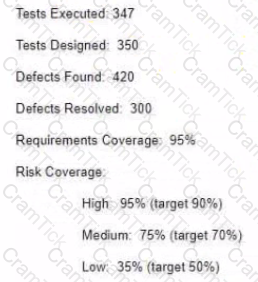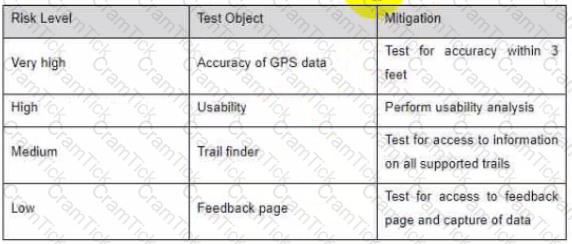Youare working on a project where the business partof the organization works traditionally with defined requirements, but the development team follows an Agile model Neither team plans to change their approach What is the proper name for this type of project approach''
Which of the following best describes the appraisal costs in the cost of quality'
You feel that your team has become lazy when applying good software testing techniques You have given each of them a challenge to take a different business rule and build a full decision table and then collapse that table You will then assess the results For this assessment, whatcompetencies are you validating?
You tend to be conservative in your project estimations because you know how many things can go wrong and extend the schedule. You manager is not happy with your estimates and thinks you are being too negative with your numbers and not trying hard enough Which estimation method should you use to provide your manager with a positive' number while still also providing the number you think is more realistic?
You have been asked to make a recommendation on deployment readiness on the software your team has been testing.You have the following metrics:

Given this information what is a critical metric you are missing?
Which of the following Is considered a heavyweight risk-based testing technique'
You are managing the test team that is testing a new mobile application that provides a "step-by-step' hiking guide Your risk assessment resulted in the following table:

Your team has clone the depth and breadth testing for the GPS accuracy and usability features but when the product was given to beta testers there were some issues Despite the users reporting the app was easy to use at least one user walked off the edge of a cliffand another one ended up in a river.Your team has confirmed that the functionality is working correctly. and the GPS information is accurate.
What other area of testing should you now prioritize?
You have been seeing a high number of rejections of defect reports The developers are complaining that they do not understand what the problem is. even though they have been supplied with screenshots. You have checked a number of the 'problem' defect reports and have not found any information that is missing. The descriptions are very detailed and include all the necessary information in a long descriptive paragraph.
What change should you recommend that should help with the developer s problems?
Which of the Mowing should be used to understand the context of testing within an organization?
Your defect opened trend is converging to the closed trend but there is still a gap. What does that gap represent?
Your manager has decided thatyour team of manual testers should all become test automation engineers Your team is much stronger in analysis than In technical testing so youare concerned about their abilityto adapt.What tool capabilities could help with this transition?
ISTQB Test Manager | ATM Questions Answers | ATM Test Prep | ISTQB Certified Tester Advanced Level - Test Manager [Syllabus 2012] Questions PDF | ATM Online Exam | ATM Practice Test | ATM PDF | ATM Test Questions | ATM Study Material | ATM Exam Preparation | ATM Valid Dumps | ATM Real Questions | Test Manager ATM Exam Questions


